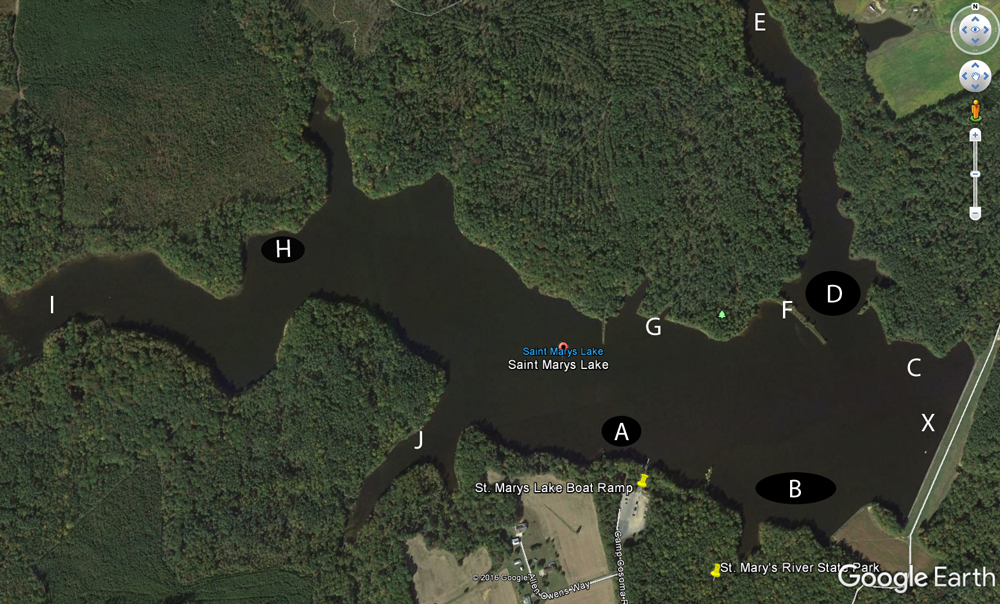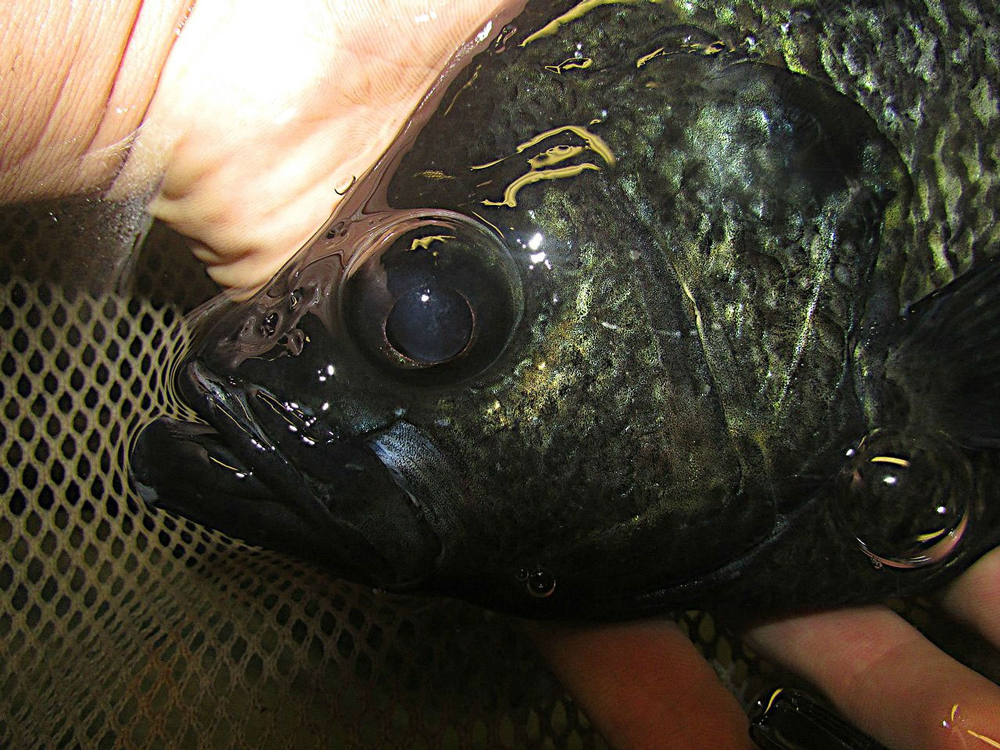By Holly Innes
Deep in the southern reaches of St. Mary’s County, Maryland, on the peninsula of land sandwiched between the Patuxent and Potomac Rivers, lies one of the best freshwater bodies of water in the area. And it’s “best” in a number of ways. A pair of modern boat ramps with a dock-in-between make launching trailer boats, kayaks, and car-toppers a piece of cake. There are hotspots within an easy cast from shore for hikers. And unlike most of the other lakes and fishing areas in the Mid-Atlantic, this one’s rarely if ever crowded.

The water here is filled with largemouth bass, crappie, sunfish, pickerel, and yellow perch. There’s structure ranging from man-made dikes jutting out into the main lake, to beaver dams, to standing timber. And no matter which way the wind blows there’s always a cove with quiet waters waiting for your arrival. When I went to school in the area (St. Mary’s College of Maryland) I spent at least as much time at the lake as in the classrooms (who am I kidding—more time, for sure) and got to know it quite well. In recent years many trips to St. Mary’s have confirmed that the fishing here is as good as ever. So let’s take an in-depth look at St. Mary’s Lake.
Trees, if you Please
Standing timber is one of the main holding areas for crappie in this lake. You’ll catch other species in the trees, for sure, but jigging with a two-inch tube jig (try red/white, blue/white, and chartreuse on a 1/16th ounce jig head) is absolutely deadly. Pull right into the timber, and jig vertically as close as you can to individual trees. At times, particularly on windy days, you’ll want to tie off to a tree to hold position. While drifting through the area will be effective, you’ll also snag trees quite often. Same goes for casting and retrieving, although probing in one direction or another will teach you—at the cost of a few jigs—where you can cast and where you’ll become fouled.
The area marked A on this shot from Google Earth is right by the boat ramps, so it sees more pressure than some of the others. Yet it still produces good catches more often than not, especially on the outer edges of the timber. Area B only has a handful of trees left standing up above the waterline but there are scads of them just beneath the surface. There will be days when you catch crappie and sunfish in this spot until your arms grow tired. Just remember that many of the trees aren’t visible unless you’re right on top of them, and you can chew up an electric trolling motor’s propeller if you’re not careful. (Note: the use of gas motors is not allowed in the lake, but if you have one permanently mounted on the transom, you’re allowed to use the boat with the outboard tilted up and out of the water at all times). Shoreline anglers will be interested to note that the trees closest to shore are within casting distance. A minnow on a marabou jig or shad dart and suspended under a bobber, cast close to these trees, is a ticket to success.
Area D is a mish-mash of trees standing upright, partially submerged, and at all angles. Pick your way through here carefully. There don’t tend to be quite as many crappie and sunfish in this stand, but there are a ton of pickerel and some bass to be found, especially around the edges. That’s just as true of the trees at H, which is in shallower water. If you want to target bass pull a spinnerbait through the trees here (they often bump over branches and stumps instead of snagging them), and if you want to target pickerel, cast a minnow on a marabou jig suspended under a bobber and creep it through the tangle of wood.
X Marks the Spot
Hotspot X is quite unusual—it’s the spillway for the lake, which drains through the dam to create the headwaters of the St. Mary’s River. Anglers on boats will want to hover near the concrete spillway and vertically jig those same small tube jigs or similar offerings to catch crappie. Quite often, there are hordes of them holding around the spillway at one depth or another. Shoreline anglers, on the other hand, need to take note of the spillway’s location because they can walk down the other side of the dam, and fish its outflow. The pond created by the outflow is small (you can cast clear across it if you’re not careful) but it’s also chock-full of fish. Bold anglers may even want to wade down into the river a bit; the first couple of holes often hold bass and crappie.

C and G mark two more areas that both shoreline and boat anglers need to be aware of. They have nice drop-offs and often weedbeds within casting distance of shore, and along them you’ll catch yellow perch, bass, and pickerel. Spot E is a bit different, though. It’s a pretty good hike (or paddle) from the parking lot, but well worth it to get here. A stream-bed runs through this creek-arm, providing a drop-off of several feet that winds from one side to the next. All the way in the back there’s a tree laying sideways across the channel (though only a few branches are visible). Drop a minnow next to the part of the tree in the deeper water, and you will catch a crappie. A note to hikers: to get within casting distance of the tree, you need to hike all the way back to the stream feeing the creek, jump across it, and hike back up to cast from the west side. Keep going to the point at the upper left corner of the E on this picture, and you’ll also find a very steep shoreline with just as steep a drop-off into deep water. The creek bed rubs right up against the point and this is the spot where I caught the biggest crappie I’ve ever seen in my life. Just don’t get overly-excited when your bobber goes down, because it’s easy to slide down this shoreline and end up in the lake… and yes, I am speaking from experience.
Bass in the Bullseye
Spots F, J, and I mark prime largemouth territory. F is a big man-made dike that juts out into the lake, and has sheer drop-offs on either side. There are several of these around the lake, but truth be told this is the only one that ever really produced much for me, personally. That “much,” however, included several bass in the four to five pound range.
The entire eastern shoreline of the cove marked J is another area that’s produced big bass. Other than a few trees and rocks it really doesn’t look like anything special, but for some reason, bass gravitate to it. Shoreline anglers will be within shooting distance of the fish here, too, but be forewarned that there aren’t many good options for shoreline anglers beyond this point, hiking in this direction around the lake—at least, none that I ever found.
The upper end of the lake, marked by the I, is another bassy area. The farther up you go the shallower it gets, the more weeds and lily pads you’ll see, and the fewer crappie, sunfish, and perch. But bass love it up here, as do pickerel during the cooler months of the year.
If you’re looking for a day on sweetwater, St. Mary’s Lake is going to be tough to beat. Very tough. In fact, if the fishing in this lake had been any better I might never have graduated from college. Seriously. So the next time you see the chance head for southern Maryland, and discover for yourself the awesome fishing experience this lake has to offer.
Sign up here to get the weekly FishTalk Chesapeake Bay and Mid-Atlantic fishing reports in your email inbox, every Friday by noon.